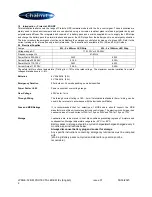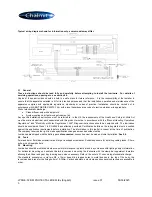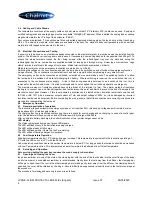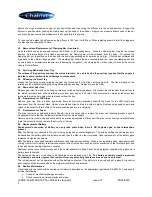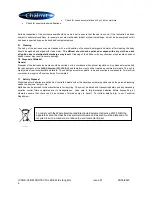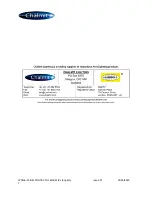
I-PRGE-32 IOM PROTECTA LED EM IEx (English)
issue 07 05/05/2020
5
Ensure the hinge mechanism is clear of any obstruction and then swing the diffuser into the closed position. Support the
diffuser in position whilst pushing the clamp bar over the edge of the diffuser. Apply even pressure at both ends of the bar
and press the bar over centre making sure that it goes fully into position.
To remove and replace the diffuser open the diffuser to 180° and it will lift out. When replacing ensure that all the hinges are
into place before attempting to close.
5.2 Removal and Replacement of Clamping Bar (if required)
Open the luminaire as above and remove the diffuser or let it swing down. Press the clamping bar towards the closed
position, tip forward beyond the closed position and the clamping bar will be released from the body. To replace the
clamping bar, put in position on the body with the front edge pointing as far inwards as it will go. Click the bar outwards and
bring back to the normal closed position. The clamping bar should then be secured in position, open the clamping bar fully
by using hand or screwdriver pressure (avoid damaging the gasket), the clamping bar is then ready to accept the normal
closure of the diffuser.
5.3 Servicing Behind the Gear Tray
The release of the gear tray exposes live mains terminals. Any work behind the gear tray requires that the supply is
isolated to avoid ignition risk and damage to components.
5.4 Releasing the Gear Tray
Loosen the four fixing screws retaining the gear tray far enough for it to slide over keyhole slots. The tray will hang on the
retaining cords without stressing the wiring between body and tray. Replace in reverse order.
5.5 Removal of Gear Tray
Release gear tray from body and hang on retaining cords, as explained above. Disconnect the cables from the gear tray to
the mains terminal block, unhook retaining cord from gear tray and lift clear. With disconnection made at the screw-less
terminals the luminaire is safe when re-closed without the tray.
5.6 Replacement of LED Strips
Remove gear tray from the body and swing down as previously explained. Identify the wires for the LED strip/s and
disconnect from the terminal block. Remove screws and clips holding the strips in place. Replace strips using screws and
clips and reconnect to terminal block. Check connections before re-energising.
5.7 Replacement of Driver
The driver contains no serviceable parts. Should it be found necessary to replace the driver, the following procedure should
be adopted: Ensure that the luminaire is isolated from the mains supply.
Remove gear tray from body and swing down as previously explained. Disconnect the driver wires from the terminal blocks
(note the connections) and remove the driver from the tray.
5.8 Replacement of Battery
Replacement/ connection of Battery can only take place when there is NO Explosive gas or dust atmosphere
present.
05L:
The battery is connected to the control using a plug and socket arrangement. The screws holding the battery pack are
loosened and the battery pack slid axially one way then the other in order to release. Upon replacement of the battery pack
remember to tighten the screws.
02L:
The battery is supplied complete with bracket and terminal connections. When removing battery pack, disconnect wires
coming from driver to battery terminal connections (wires from battery pack must stay connected to the terminal block) and
remove battery assembly. Replace in reverse.
Additional wiring connections are required if the heater assembly is fitted. Consult wiring diagram supplied with replacement
battery pack for details.
The battery packs are not intended to be opened and are replaced as a unit.
The battery assembly must be protected
from damage and water ingress then
removed from any potentially hazardous area as soon as practical.
The luminaire must not be operated without the battery connected. If the battery is removed and not replaced, the control
gear supply must be disconnected at the mains terminal block and secured.
6.0 Routine Maintenance
Visual tests and checks should be carried out at intervals described by the appropriate regulations, EN 60079-17, and should
include the following:
Check for mechanical damage/corrosion.
Check connections, fixings, glands and plugs.


